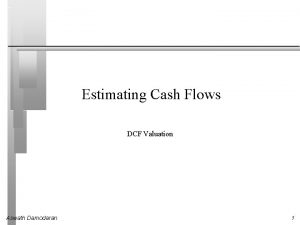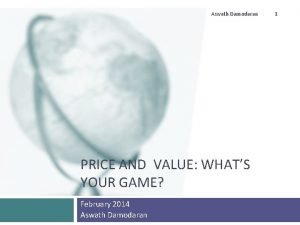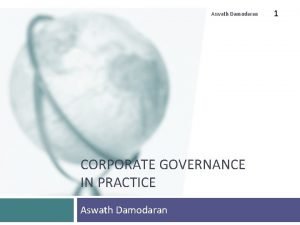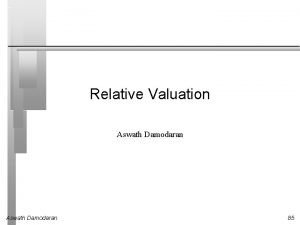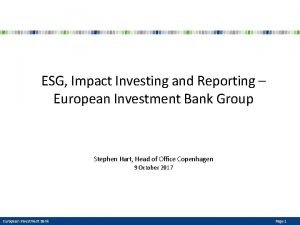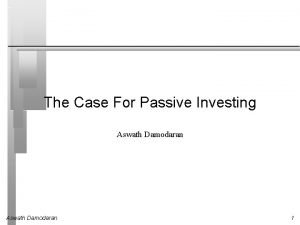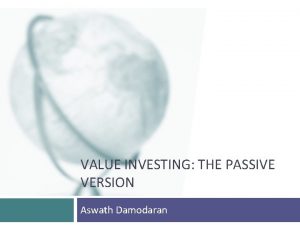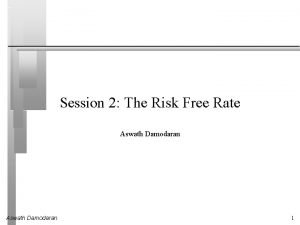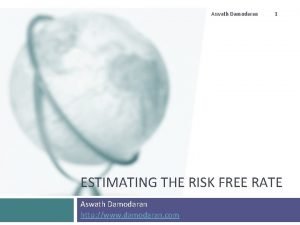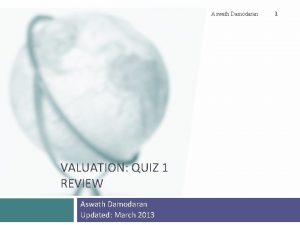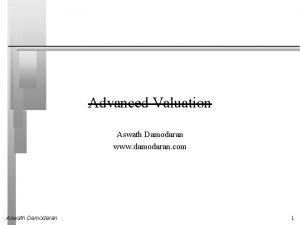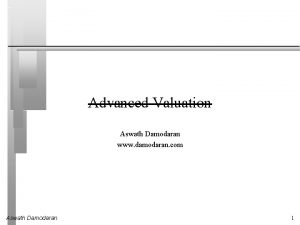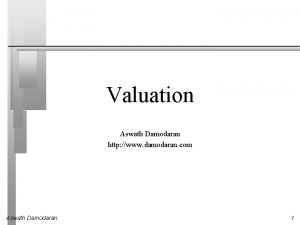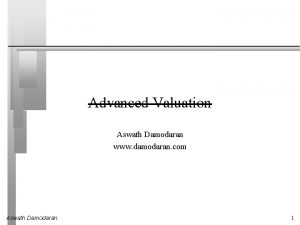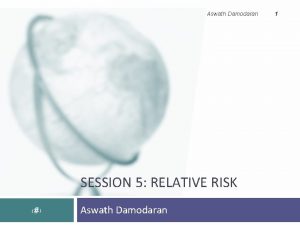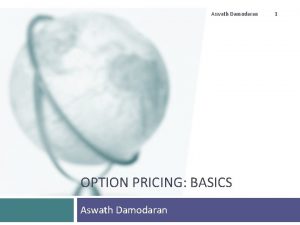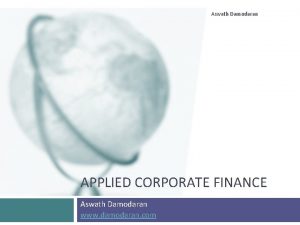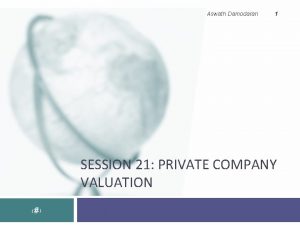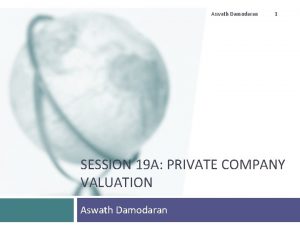Aswath Damodaran 1 SESSION 21 PRIVATE COMPANY VALUATION
















- Slides: 16

Aswath Damodaran 1 SESSION 21: PRIVATE COMPANY VALUATION ‹#›

Private Business Valuation 2 Aswath Damodaran 2

Private Company Valuation: Motive matters You can value a private company for � � � ‘Show’ valuations Transaction valuations As prelude to setting the offering price in an initial public offering You can value a division or divisions of a publicly traded firm � � � As prelude to a spin off For sale to another entity To do a sum-of-the-parts valuation to determine whether a firm will be worth more broken up or if it is being efficiently run. 3 Aswath Damodaran 3

Private company valuations: Four broad scenarios Private to private transactions: You can value a private business for sale by one individual to another. Private to public transactions: You can value a private firm for sale to a publicly traded firm. Private to IPO: You can value a private firm for an initial public offering. Private to VC to Public: You can value a private firm that is expected to raise venture capital along the way on its path to going public. 4 Aswath Damodaran 4

I. Private to Private transaction In private to private transactions, a private business is sold by one individual to another. There are three key issues that we need to confront in such transactions: Neither the buyer nor the seller is diversified The investment is illiquid Key person value 5 Aswath Damodaran 5


Lesson 1: In private businesses, risk in the eyes of the “beholder” (buyer) 7

Total Risk versus Market Risk Adjust the beta to reflect total risk rather than market risk. This adjustment is a relatively simple one, since the R squared of the regression measures the proportion of the risk that is market risk. � Total Beta = Market Beta / Correlation of the sector with the market To estimate the beta for Kristin Kandy, we begin with the bottom-up unlevered beta of food processing companies: � � � Unlevered beta for publicly traded food processing companies = 0. 78 Average correlation of food processing companies with market = 0. 333 Unlevered total beta for Kristin Kandy = 0. 78/0. 333 = 2. 34 Debt to equity ratio for Kristin Kandy = 0. 3/0. 7 (assumed industry average) Total Beta = 2. 34 ( 1 - (1 -. 40)(30/70)) = 2. 94 Total Cost of Equity = 4. 50% + 2. 94 (4%) = 16. 26% 8

Lesson 2: With financials, trust but verify. . 1. 2. 3. 4. Different Accounting Standards: Looser and more diverse accounting standards. Intermingling of personal and business expenses: Personal expenses may be reported as business expenses. Separating “Salaries” from “Dividends”: No separation between the two for sole owner. . The Key person issue: In some private businesses, with a personal component, the cashflows may be intertwined with the owner being part of the business. 9

Lesson 3: Illiquidity is a clear and present danger. . In private company valuation, illiquidity is a constant theme. All the talk, though, seems to lead to a rule of thumb. The illiquidity discount for a private firm is between 20 -30% and does not vary across private firms. But illiquidity should vary across: Companies: Financial healthy, Cash flows and Asset type � Time: Liquidity is worth more when markets are in crisis. � Buyers: Liquidity is worth more to buyers who have shorter time horizons and greater cash needs. � 10

II. Private company sold to publicly traded company The key difference between this scenario and the previous scenario is that the seller of the business is not diversified but the buyer is (or at least the investors in the buyer are). Consequently, they can look at the same firm and see very different amounts of risk in the business with the seller seeing more risk than the buyer. The cash flows may also be affected by the fact that the tax rates for publicly traded companies can diverge from those of private owners. Finally, there should be no illiquidity discount to a public buyer, since investors in the buyer can sell their holdings in a market. 11 Aswath Damodaran 11

III. Private company for initial public offering In an initial public offering, the private business is opened up to investors who clearly are diversified (or at least have the option to be diversified). There are control implications as well. When a private firm goes public, it opens itself up to monitoring by investors, analysts and market. The reporting and information disclosure requirements shift to reflect a publicly traded firm. 12 Aswath Damodaran 12

13 Aswath Damodaran

The twists in an initial public offering Valuation issues: � � Use of the proceeds from the offering: Proceeds can be taken out of the firm, held as cash or used to retire debt. Warrants/ Special deals with prior equity investors: Option claims from prior equity offerings may stay on. Pricing issues: � � Institutional set-up: Most IPOs are backed by investment banking guarantees on the price, which can affect how they are priced. Follow-up offerings: The proportion of equity being offered at initial offering and subsequent offering plans can affect pricing. 14 Aswath Damodaran 14

IV. An Intermediate Problem Private to VC to Public offering… Assume that you have a private business operating in a sector, where publicly traded companies have an average beta of 1 and where the average correlation of firms with the market is 0. 25. Consider the cost of equity at three stages (Riskfree rate = 4%; ERP = 5%): Stage 1: The nascent business, with a private owner, who is fully invested in that business. Perceived Beta = 1/ 0. 25 = 4 Cost of Equity = 4% + 4 (5% ) = 24% Stage 2: Angel financing provided by specialized venture capitalist, who holds multiple investments, in high technology companies. (Correlation of portfolio with market is 0. 5) Perceived Beta = 1/0. 5 = 2 Cost of Equity = 4% + 2 (5%) = 14% Stage 3: Public offering, where investors are retail and institutional investors, with diversified portfolios: Perceived Beta = 1 Cost of Equity = 4% + 1 (5%) = 9% 15 Aswath Damodaran 15

To value this company… Assume that this company will be fully owned by its current owner for two years, will access the technology venture capitalist at the start of year 3 and that is expected to either go public or be sold to a publicly traded firm at the end of year 5. 1 2 3 4 5 Terminal year E(Cash flow) Market beta Correlation Beta used Cost of equity Terminal value Cumulated COE PV $100 1 0. 25 4 $125 1 0. 25 4 $150 1 0. 5 2 $165 1 0. 5 2 $170 1 0. 5 2 $175 1 1 1 24. 00% 14. 00% 9. 00% $2, 500 1. 2400 $80. 65 1. 5376 $81. 30 1. 7529 $85. 57 1. 9983 $82. 57 2. 2780 $1, 172. 07 2. 4830 Value of firm $1, 502 (Correct value, using changing costs of equity) Value of firm $1, 221 (using 24% as cost of equity forever. You will undervalue firm) 16 Value of firm $2, 165 (Using 9% as cost of equity forever. You will overvalue firm) Growth rate 2% forever after year 5 175/ (. 09 -. 02) 16
 Private company valuation damodaran
Private company valuation damodaran Startup valuation damodaran
Startup valuation damodaran Damodaran
Damodaran Damodaran multiple
Damodaran multiple Non cash working capital dcf
Non cash working capital dcf Aswath damodaran intrinsic value
Aswath damodaran intrinsic value Aswath damodaran age
Aswath damodaran age Growth investment definition
Growth investment definition Damodaran relative valuation
Damodaran relative valuation Aswath damodaran
Aswath damodaran Aswath damodaran esg
Aswath damodaran esg Aswath damodaran net worth
Aswath damodaran net worth Aswath damodaran
Aswath damodaran Aswath damodaran value investing
Aswath damodaran value investing Default spread damodaran
Default spread damodaran Default spread damodaran
Default spread damodaran Damodaran on valuation review
Damodaran on valuation review




